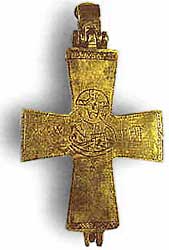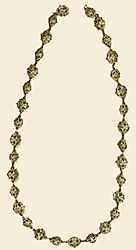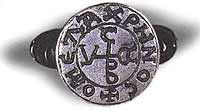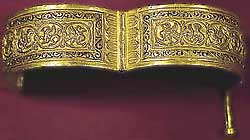  |

|

Fig. 7 Bronze reliquary cross engraved
on the front with a bust of Christ Pantocrator. On the back the
inscription: A.KÙÍCTANTHNOC, probably the namesake and
patron saint of the owner.
10th-11th century.
Athens, Benaki Museum, inv.no 11412. Dimensions: 10 X 5.7cm.
|

Fig. 11 . Gold necklace of 32 spherical
beads with lacy floral decoration. Length: 87 cm.
l7th - l8th centuries. Athens,
Byzantine Museum, T 501a
|
|

Fig. 9 Encolpium with Christ Pantocrator.
12th century in 16th century mount. Rock crystal, gold, gemstones
and pearls. At the center of the encolpium an octagonal rock crystal
cameo with a bust of the Pantocrator. Around the halo the
inscription: IC XC РANTOKPAT/OP
Athens, Benaki Museum, inv. no. 2115. Dimensions: 6.1 X 6cm
|

Fig. 10 Athens, Byzantine Museum, T 1664.
Silver ring with circular bezel bearing the monogram-seal BЛACIOC
O MEЛAXPHNOC.
l3th - l4th centuries.
Diameter: 2.8 cm.
|
|

Fig. 8 Gold pericarpium consisting of two
semi cylindrical sections of sheet metal with repousse decoration,
linked by pins. On each section a broad zone of chased lions,
griffins and birds inscribed in five tangent circles. Around the
zone a narrow frame of inlaid niello. The most refined pericarpia
were courtly ornaments worn by the empress's
maids-in-waiting.
Athens, P and A. Canellopoulos Museum, inv no 14. Diam. 7ch. H. 3
cm.
|
Diadems, gold and gem-studded ornaments for the hair, chains with lovely
pendants, coins, encolpia and pectoral crosses; earrings, rings, pericarpia,
bracelets, belts, buckles, buttons; these are the kosmia or kosmidia with which
Byzantine women, and .men too, adorned themselves. Conspicuous signs of
nobility, social status, office, vanity, taste and wealth, valuable ornaments of
the marriage rite and costly mementoes of joy, their haughty power vanquish- es
the commandments of Christian humility and simplicity recommended by the Fathers
of the Church. Plain and modest or intricate and opulent, they accord with the
concept of grandeur and reigned in the life of the Byzantines, giving their
felicitous owners delicate aesthetic pleasure.
The amount of jewellery preserved in Greek and foreign museums, private
collections and the sacristies of churches and monasteries is extremely small in
relation to the compass and duration of the Byzantine Empire. Many pieces were
pan of private treasures (hoards), hidden in the earth in times of danger and
invasion, along with other precious possessions, often with tightly sealed
silver and gilt vessels, as well as coins that date them exactly. Ornaments from
hoards, sporadic finds from excavations, keimelia from sacristies; Byzantine
jewellery has been recovered from Constantinople, Asia Minor, Greece, Cyprus,
Italy, Syria and Egypt; from France, Germany, Hungary, Bulgaria, the Crimea and
Georgia, which lands it reached - as elsewhere - via the routes of trade,
diplomacy and war. In their way these pieces too bear witness to the
superiority, the artistic influence and radiance of Byzantium in the Medieval
world, in the world beyond its borders to which these jewels were sometimes sent
as choice imperial gifts to foreign rulers.
The Byzantine jewellery extant today - more from certain periods such as the
seventh century, less from others - gives but a circumstantial and certainly
incomplete picture of this Flourishing art that combined gold- and silver-smithing
with glyptic and the outstanding minor art of Byzantium, enamelling, frequently
in works of superb symmetry and splendid coloration, incomparable technique and
masterly execution. The finest pieces are attributed to the workshops of
Constantinople.
|
|


|
Greece jewellery pages Copyright ©
by Add
Information Systems. (Greece)
|
|
  |

